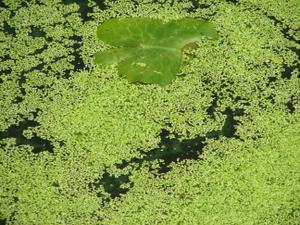Here is the 
occasional feature from the Center for the Urban Environment. This post was written by Jennifer Mokos, the Program Manager for Service Learning at the Center. To learn more about the Center visit: www.bcue.org.
Prospect Park Lake is often covered in a green substance (see here), sometimes referred to as “pond scum” or maybe, more kindly, “algae.” But that green film you see is actually made up thousands of tiny plants called duckweed. If you look closely, you can see very small leaves floating on top of the water. Each duckweed plant is made up of two leaves joined together at the base. Simple threadlike roots reach down from the leaves into the water.
Duckweed may be small, but it is not a type of algae. Algae are a primitive type of plant—they do have chlorophyll—but they do not have true roots, leaves, stems, flowers, or seeds. Duckweed is a member of the family Lemnaceae, the smallest seed-bearing plants. However, it is rare to see duckweed flowering. They reproduce primarily by budding—a pouch forms on the bottom of a leaf, which eventually grows into a new leaf. The new leaf can split off from the parent plant, forming a new plant, which is a clone of the original. Duckweed, as you may have observed in Prospect Park , forms a dense floating mat on ponds and lakes. As its name implies, it is an important source of food for ducks and other waterfowl.
As winter approaches, duckweed produces thick bulbs filled with starches that sink down to the bottom of the lake. The thick coating protects the bulbs from the cold winter water, while the starches provide nourishment in the light-starved lake bottom. The duckweed bulbs spend the winter in a dormant state at the bottom of the lake. In late spring, the water in lakes and ponds mix completely through a process called spring overturn. As the water from the bottom of the lake rises, duckweed bulbs are carried to the surface. The bulbs sprout into adult plants in the warmer temperatures and increased light. As the duckweed plants reproduce, they form the dense mat you see covering the surface of the Prospect Park Lake throughout the summer.
